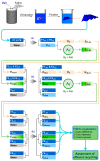Removal of Reactive Dyes in Textile Effluents by Catalytic Ozonation Pursuing on-Site Effluent Recycling
- PMID: 31362453
- PMCID: PMC6695600
- DOI: 10.3390/molecules24152755
Removal of Reactive Dyes in Textile Effluents by Catalytic Ozonation Pursuing on-Site Effluent Recycling
Abstract
The textile wash-off process consumes substantial amounts of water, which generates large volumes of wastewater that pose potential pollution issues for the environment. In the present study, catalytic ozonation was applied to degrade residual dyes present in rinsing effluents from wash-off processes towards the aim of recycling the waste effluents. A magnetic catalyst was prepared for promoting dye degradation by catalytic ozonation. Via a hydrothermal reaction, highly magnetic manganese ferrite (MnFe2O4) particles were successfully loaded on carbon aerogel (CA) materials (MnFe2O4@CA). The results showed that the developed catalyst strikingly promoted the degradation of dye contaminants by catalytic ozonation, in terms of color removal and reduction of chemical oxidation demand (COD) in rinsing effluents. COD removal efficiency in catalytic ozonation was enhanced by 25% when compared with that achieved by ozonation alone under the same treatment conditions. Moreover, we confirmed that after catalytic ozonation, the rinsing effluents could be recycled to replace fresh water without any evident compromise in the color quality of fabrics. The color difference (ΔEcmc(2:1)) between fabrics treated with recycled effluents and water was not more than 1.0, suggesting that the fabrics treated with recycled effluents displayed acceptable color reproducibility. Although colorfastness and color evenness of fabrics treated with recycled effluents were slightly poorer than those of fabrics treated with water, they were still within the acceptable tolerance. Therefore, the present study validated that catalytic ozonation was a promising technology for saving water and wastewater elimination in textile dyeing. It provides a feasibility assessment of catalytic ozonation for recycling waste effluents to reduce water dependence in textile production. Furthermore, we show a new perspective in on-site recycling waste effluents by catalytic ozonation and enrich the knowledge on feasible approaches for water management in textile production.
Keywords: catalytic ozonation; effluent recycling; fabric color quality; magnetic collection; textile dyeing.
Conflict of interest statement
The authors declare no conflict of interest.
Figures














Similar articles
-
Minimizing Freshwater Consumption in the Wash-Off Step in Textile Reactive Dyeing by Catalytic Ozonation with Carbon Aerogel Hosted Bimetallic Catalyst.Polymers (Basel). 2018 Feb 15;10(2):193. doi: 10.3390/polym10020193. Polymers (Basel). 2018. PMID: 30966229 Free PMC article.
-
Catalytic ozonation of organic pollutants from bio-treated dyeing and finishing wastewater using recycled waste iron shavings as a catalyst: Removal and pathways.Water Res. 2016 Apr 1;92:140-8. doi: 10.1016/j.watres.2016.01.053. Epub 2016 Jan 28. Water Res. 2016. PMID: 26849317
-
Effect of some operational parameters on the decolorization of textile effluents and dye solutions by ozonation.Environ Technol. 2005 Feb;26(2):135-43. doi: 10.1080/09593332608618573. Environ Technol. 2005. PMID: 15791794
-
Textile dye degradation using nano zero valent iron: A review.J Environ Manage. 2016 Jul 15;177:341-55. doi: 10.1016/j.jenvman.2016.04.034. Epub 2016 Apr 26. J Environ Manage. 2016. PMID: 27115482 Review.
-
Progress in membrane distillation processes for dye wastewater treatment: A review.Chemosphere. 2024 Jul;360:142347. doi: 10.1016/j.chemosphere.2024.142347. Epub 2024 May 15. Chemosphere. 2024. PMID: 38759802 Review.
Cited by
-
Preparation and Thermal Properties of Magnetic PW@CaCO3@Fe3O4 Phase-Change Microcapsules and Their Application to Textile Fabrics.Molecules. 2024 Aug 31;29(17):4151. doi: 10.3390/molecules29174151. Molecules. 2024. PMID: 39274999 Free PMC article.
-
Activated Iron-Porous Carbon Nanomaterials as Adsorbents for Methylene Blue and Congo Red.Molecules. 2024 Aug 29;29(17):4090. doi: 10.3390/molecules29174090. Molecules. 2024. PMID: 39274938 Free PMC article.
-
Recent Achievements in Dyes Removal Focused on Advanced Oxidation Processes Integrated with Biological Methods.Molecules. 2021 Feb 6;26(4):870. doi: 10.3390/molecules26040870. Molecules. 2021. PMID: 33562176 Free PMC article. Review.
-
Mechanism of One-Step Hydrothermally Synthesized Titanate Catalysts for Ozonation.Molecules. 2022 Apr 22;27(9):2706. doi: 10.3390/molecules27092706. Molecules. 2022. PMID: 35566056 Free PMC article.
-
Recovery of resources from industrial wastewater employing electrochemical technologies: status, advancements and perspectives.Bioengineered. 2021 Dec;12(1):4697-4718. doi: 10.1080/21655979.2021.1946631. Bioengineered. 2021. PMID: 34334104 Free PMC article. Review.
References
-
- Li F., Huang J., Xia Q., Lou M., Yang B., Tian Q., Liu Y. Direct contact membrane distillation for the treatment of industrial dyeing wastewater and characteristic pollutants. Sep. Purif. Technol. 2018;195:83–91. doi: 10.1016/j.seppur.2017.11.058. - DOI
-
- Zhang H., Hou A., Xie K., Gao A. Smart color-changing paper packaging sensors with pH sensitive chromophores based on azo-anthraquinone reactive dyes. Sens. Actuat. B Chem. 2019;286:362–369. doi: 10.1016/j.snb.2019.01.165. - DOI
-
- Shang S.M. Process control in dyeing of textiles. In: Majumdar A., Das A., Alagirusamy R., Kothari V.K., editors. Process Control in Textile Manufacturing. Woodhead Publishing; Cambridge, UK: 2013. pp. 300–338.
-
- Zhang X.Q., Fang K.J., Zhang J.F., Shu D.W., Gong J.X., Liu X.M. A vacuum-dehydration aided pad-steam process for improving reactive dyeing of cotton fabric. J. Clean Prod. 2017;168:1193–1200. doi: 10.1016/j.jclepro.2017.09.112. - DOI
-
- Pisitsak P., Tungsombatvisit N., Singhanu K. Utilization of waste protein from Antarctic krill oil production and natural dye to impart durable UV-properties to cotton textiles. J. Clean Prod. 2018;174:1215–1223. doi: 10.1016/j.jclepro.2017.11.010. - DOI
MeSH terms
Substances
Grants and funding
LinkOut - more resources
Full Text Sources
Medical

